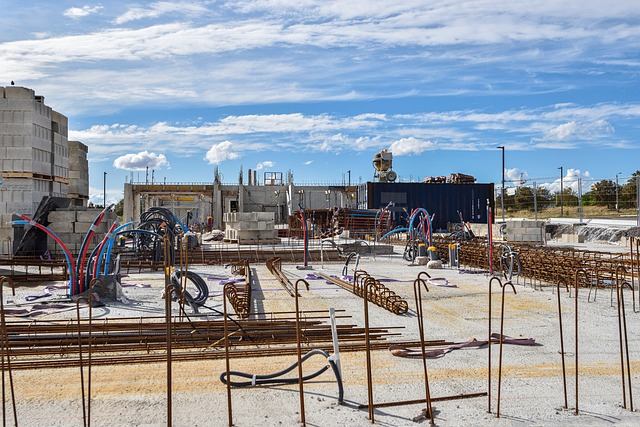Foundation cracks, caused by settlement, shifting soil, and extreme temperatures, signal potential structural damage. Homeowners should visually inspect walls, floors, and ceilings for gaps or cracks, especially around doors and windows. For minor cracks, non-invasive methods like carbon fiber wrapping (reinforcement) and epoxy injection (filling) offer cost-effective solutions. Structural repairs, such as steel beam insertion and bracket installation, address deeper issues in older homes. Foundation jacking lifts sinking foundations, while piering supports houses on unstable soil. Carbon fiber wrapping provides long-lasting stability for extensive crack networks without invasive modifications. Epoxy injection fixes wider cracks with superior strength compared to conventional fillers. Regular inspections, maintenance, proper drainage, and high-quality construction materials prevent foundation issues. Cracks wider than 0.25 inches or growing over time require professional evaluation for tailored Foundation Solutions, like underpinning, piering, wall anchors, or slab jacking, to prevent further damage and ensure structural integrity.
Foundational cracks can range from harmless aesthetics to serious structural issues, necessitating prompt action. This guide explores comprehensive Foundation Solutions for addressing these concerns. We break down the intricate world of residential foundation cracks, delving into their causes and types, from hairline fissures to expansive gaps. Learn effective assessment methods, discover non-invasive repair techniques like carbon fiber wrapping and epoxy injection, and explore advanced stabilization strategies. By understanding these solutions, homeowners can ensure their home’s longevity and stability.
Understanding Foundation Cracks: Causes and Types

Foundation cracks can be both aesthetically concerning and structurally damaging, but understanding their causes is the first step to effective foundation solutions. These cracks typically occur due to a variety of factors including settlement, shifting soil, extreme temperatures, poor construction, or existing structural issues. Settlement, for instance, happens when the soil beneath your home compacts or expands unevenly, putting stress on the foundation and leading to cracks. Shifting soil, often due to changes in moisture levels, can also cause foundational movement, resulting in cracks that may appear over time.
There are several types of foundation cracks, each with its own potential implications. Horizontal cracks usually indicate severe settlement or heave (soil expansion), while vertical cracks suggest differential settling or other structural problems. Diagonal cracks could be an indication of soil movement or a combination of both horizontal and vertical forces. Identifying the type and cause of the crack is crucial in determining the appropriate foundation solutions, which can range from minor repairs to extensive structural stabilization measures.
Assessing the Extent of Damage: Visual Inspection

When assessing foundation cracks, a visual inspection is the first step in understanding the extent of the damage. Homeowners should carefully examine the structure for any visible cracks or gaps, paying close attention to their width and length. Even small cracks can indicate significant issues beneath the surface, especially if they are widening over time. Foundation solutions often begin with this crucial evaluation, as it helps identify whether the problem is superficial or requires more intensive intervention.
During the visual inspection, look for cracks in both interior and exterior walls, floors, and ceilings. Pay special attention to areas around doors and windows, as well as any signs of uneven floors or sticking doors. These indicators could suggest structural instability caused by foundation movement, which may require professional evaluation and tailored foundation solutions to address the problem effectively.
Non-Invasive Repair Methods for Minor Cracks

For minor cracks in residential foundations, non-invasive repair methods offer a cost-effective and efficient solution. These techniques are designed to stabilize the structure without causing further damage or disturbing the surrounding area. One popular approach is carbon fiber wrapping, where strong carbon fiber fabric is applied over the crack to reinforce it. This method is particularly effective for preventing further expansion of the crack and promoting healing.
Another less invasive option is the use of epoxy injection. Epoxy resin is injected into the crack, filling it completely and providing a durable seal. Unlike traditional repair methods that require extensive excavation, these non-invasive techniques are quick, clean, and minimize disruption to the homeowner’s property, making them ideal foundation solutions for maintaining the structural integrity of your home.
Structural Repairs: Reinforcement and Stabilization Techniques

Structural repairs are a crucial aspect of addressing foundation cracks, offering long-term solutions for stabilizing and reinforcing the overall structure. Techniques such as steel beam insertion and bracket installation can effectively mitigate further damage by distributing weight evenly and preventing the spread of cracks. These methods are particularly useful for older homes with inadequate initial construction or those experiencing soil settlement issues.
Foundation solutions often involve advanced techniques like piering, which involves installing metal piers beneath the foundation to lift and stabilize it. This process is ideal for houses on unstable soil or those with sinkhole damage. By reinforcing the foundation, these methods ensure structural integrity, preventing costly repairs down the line.
Foundation Jacking: A Step-by-Step Guide

Foundation jacking is a process used to lift and stabilize a sinking or uneven foundation, offering an effective solution for many residential foundation issues. This technique involves carefully inflating pillows or jacks beneath the foundation, providing the necessary force to raise it to its proper level.
Here’s a simplified step-by-step guide: First, an expert inspector assesses the damage and identifies the problem areas. Next, holes are drilled at strategic locations, and hydraulic foundation jacks are installed. These jacks are then inflated, gradually lifting the foundation until it reaches the desired height. Once in place, the jacks support the weight of the structure, allowing for any necessary adjustments to ensure stability. This method is a non-invasive approach that provides immediate results, making it a popular choice among homeowners seeking foundation crack solutions and long-term foundation repair.
Carbon Fiber Wrapping: A Modern Solution

Carbon fiber wrapping is a modern and innovative solution for foundation crack repairs, offering an effective and durable fix for residential structures. This technique involves applying a carbon fiber composite material directly over existing cracks, providing exceptional strength and stability to the affected area. The flexible yet robust nature of carbon fiber allows it to conform to the shape of the crack, ensuring a tight seal that prevents further damage or movement.
This method is particularly advantageous for older homes with extensive crack networks as it provides a long-lasting solution without the need for invasive structural modifications. By wrapping the cracks, homeowners can effectively stabilize their properties and mitigate potential safety risks associated with structural instability. Carbon fiber wrapping also offers excellent resistance to moisture penetration, which is crucial in preventing further damage caused by water intrusion.
Epoxy Injection: Filling the Gaps

Epoxy injection is a highly effective method for repairing foundation cracks, particularly those caused by settlement or movement. This process involves injecting a mixture of epoxy and aggregate into the crack, which then hardens to fill any gaps. Epoxy offers superior strength and durability compared to traditional filling materials, making it an excellent long-term solution for foundation repair. By sealing these cracks, epoxy injection prevents further damage and water intrusion, thereby stabilizing the structure and preserving its integrity.
This technique is particularly useful for wider cracks or those in hard-to-reach areas. The epoxy mixture can be tailored to suit specific crack sizes and conditions, ensuring a precise and customized repair. Foundation solutions like epoxy injection not only restore structural stability but also enhance the overall durability of the building, providing homeowners with peace of mind.
Preventative Measures: Long-Term Foundation Care

Regular inspection and maintenance are key to preventing foundation cracks, which can be costly to repair. Homeowners should schedule periodic assessments to identify any signs of damage or movement in the structure. This proactive approach allows for early intervention, addressing issues before they escalate. Implementing measures like proper drainage around the house, ensuring stable soil conditions, and avoiding excessive moisture near foundations can significantly reduce crack formation.
Additionally, using high-quality construction materials and employing expert contractors during initial buildup can contribute to stronger foundation solutions. Regular concrete repairs, sealing, and monitoring of basement levels are further preventative steps. By combining these strategies, homeowners can extend the lifespan of their structures, saving time and money in the long term.
When to Call a Professional: Expert Intervention

If you notice cracks in your home’s foundation that are wider than 0.25 inches or growing over time, it’s crucial to consider professional intervention. While smaller cracks might not immediately signal a severe problem, they can indicate potential issues like settlement, shifting soil, or structural damage caused by changes in temperature and humidity. Foundation solutions experts are equipped with the knowledge and tools to assess these cracks accurately.
Professionals can also identify the root cause of the cracks, which is essential for effective long-term foundation repair. They offer a range of foundation solutions tailored to specific needs, from underpinning and piering to wall anchors and slab jacking. Promptly addressing foundation issues is key to preventing further damage, maintaining your home’s structural integrity, and ensuring safety for you and your family.
